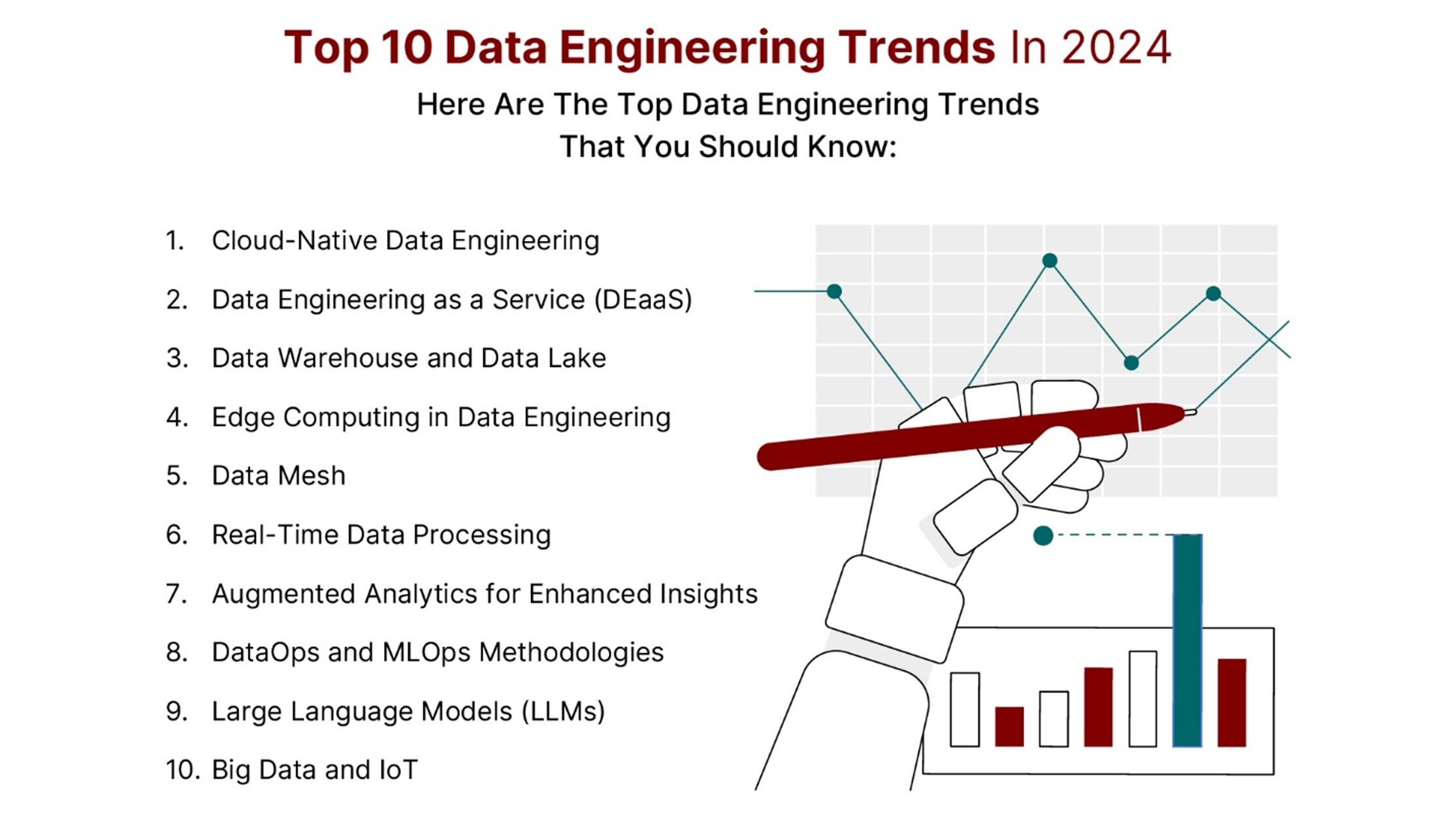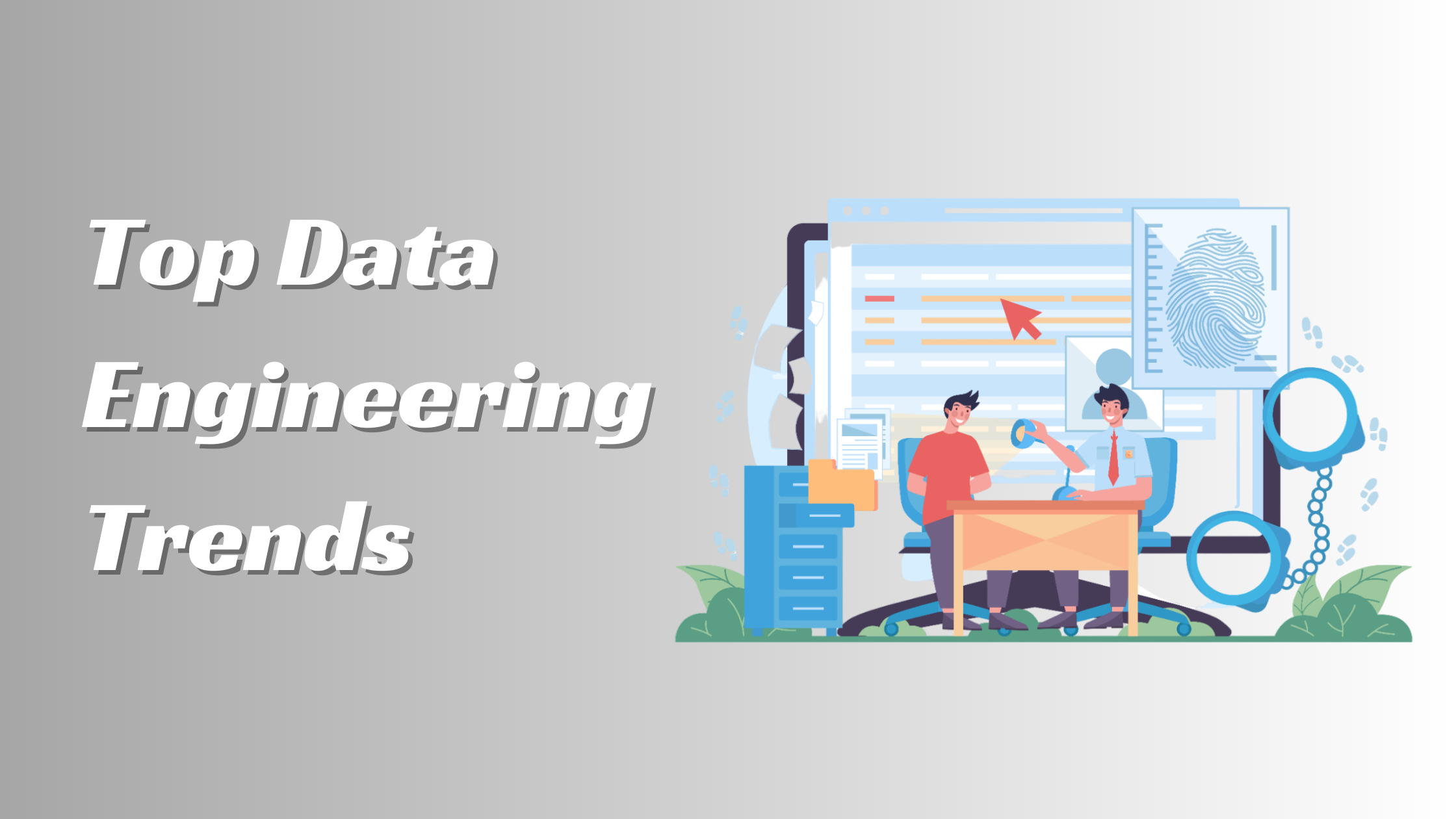Top Data Engineering Trends 2024
- 1 Top 10 Data Engineering Trends in 2024
- 1.1 Cloud-Native Data Engineering
- 1.2 Data Engineering as a Service (DEaaS)
- 1.3 Big Data and IoT
- 1.4 Data Warehouse and Data Lake
- 1.5 Edge Computing in Data Engineering
- 1.6 Data Mesh
- 1.7 Real-Time Data Processing
- 1.8 Augmented Analytics for Enhanced Insights
- 1.9 DataOps and MLOps Methodologies
- 1.10 Large Language Models (LLMs):
- 2 Conclusion
Data has become hugely important for many industries when making strategic choices. Effectively using engineering tools and expertise is necessary. As companies aim to leverage data insights, the need for robust engineering solutions keeps growing. Businesses need to stay up-to-date on innovations in this area if they want to apply modern data techniques.
Data engineering trends in 2024 will undoubtedly impact how companies interact with their information. Understanding emerging trends can help them navigate ever-changing options for managing and utilizing their data engineering services. Let’s examine ten significant trends expected to transform the field.
Top 10 Data Engineering Trends in 2024

Here are the top data engineering trends in 2024 that you should know:
Cloud-Native Data Engineering
A cloud-native approach to data engineering is also catching up fast and is set to be a significant trend in 2024.
- With the increase of cloud platforms such as AWS, Azure, and Google Cloud, companies are moving data storage and processing to the cloud.
- It brings scalability, flexibility, and cost-effectiveness. Such an arrangement makes the management of data possible, as well as improves the administration of infrastructure.
- With their streamlined operations, data companies have already acquired considerable insights from their storage.
Data Engineering as a Service (DEaaS)
Another rising trend is Data Engineering as a Service (DEaaS).
- DEaaS allows companies to access expert data professionals without hiring them directly.
- DEaaS agents handle all engineering activities, which include importing data, transformation, deployment, and monitoring.
- It hands responsibilities to experts and lightens the load for internal teams.
- As data sources and types become more complex, companies are interested in DEaaS due to outsourcing specialized functions.
- Leveraging external engineering help via DEaaS improves how companies manage and interpret their increasing data pools.
Big Data and IoT
Extensive data engineering services and the Internet of Things (IoT) go hand in hand.
- IoT devices and sensors generate vast amounts of information from different sources. As more devices connect to the internet, data volumes are predicted to increase exponentially.
- To handle this influx, data engineers will need innovative ways to store and process large amounts of data efficiently in real-time.
- Tools like Apache Kafka and Flink will be crucial for analyzing IoT-generated data in real-time and ensuring security across all connected devices.
- As data streams in from more entry points, engineering practices must advance to help companies maintain oversight.
Data Warehouse and Data Lake
Data warehouses and data lakes are also critical technologies.
- Data warehouses store processed information tailored for reporting and business analysis.
- Data lakes serve as repositories for raw, unstructured, or semi-structured data.
- The symbiotic relationship between warehouses and lakes provides companies with a holistic solution for all data needs. It allows them to collect, organize, and leverage different data types comprehensively.
- Their cooperative roles optimize how companies maintain and gain insights from vast information assets.
Edge Computing in Data Engineering
Edge computing is a big step forward in data engineering in 2024.
- It involves analyzing data closer to where it originates. This reduces response times and boosts productivity, especially for real-time analysis and dynamic decision-making.
- With more IoT technologies and demands for quick insights, edge computing provides practical ways to handle data at its source for timely and streamlined processing.
- As information volumes explode from a growing number of connected devices, edge solutions help engineering practices scale effectively.
Data Mesh
Data mesh is also emerging as a significant development in 2024.
- It takes a decentralized approach to managing data, unlike traditional centralized systems.
- Data mesh empowers teams focused on particular domains to own and control their data. This strategic shift towards domain-oriented setups improves organizations’ collaboration, efficiency, and data ownership.
- Proficiency with APIs, microservices architecture, and analytics tools becomes key as engineers work closely with subject matter experts.
- This helps them better understand specific data needs and business contexts, optimizing the value of data assets for organizations.
Real-Time Data Processing
It is the most notable technological advancement in data engineering. In 2024, the focus will be on real-time data analysis.
- As information increases, businesses face the issue of techniques for using data insights as they appear.
- Companies are provided with the advantage of real-time analysis, which enables them to identify and make quick decisions.
- Engineers can use tools like Apache Kafka and Apache Flink. These tools can help build data pipelines that receive data from multiple sources in real time.
- Engineers can conduct live studies, which results in more informed decisions and swift adaptation to changes by companies.
Augmented Analytics for Enhanced Insights
Augmented analytics, which uses artificial intelligence (AI) and machine learning, is expected to transform data exploration in 2024.
- This evolving technology combines several analytical tools to automatically generate visuals, spot aberrations, and deliver forecasting insights.
- Data analysis becomes more accessible to more people within an organization by reducing process duration and ensuring an insightful report is available.
- This breakthrough might improve decision-making across sectors by increasing efficiency and continuing innovation as engineering develops.
- It can potentially alter how companies use the information they collect.
DataOps and MLOps Methodologies
DataOps and MLOps are gaining popularity, which will likely continue in 2024.
- DataOps and DevOps skills enable real-time data interaction with cloud-based systems.
- These skills emphasize cooperation, automation, and continual development. This provides efficient and reliable work processes that may expand over time.
- Implementing DataOps and MLOps frameworks may save development time. Hence, companies can enhance data quality and deploy AI models on a larger scale.
- DataOps and DevOps bridge the gap between data science and real-world applications, enabling companies to maximise their data.
Large Language Models (LLMs):
Advanced AI systems like LLMs are transforming how we work with data.
- LLMs are increasing the demand for efficient storage and processing options as they are trained in large amounts of text and code,
- Data engineers must adjust their techniques as companies use these models to solve complex problems. They will need to use vector databases and concentrate on user-friendly manipulation techniques.
- Integrating these AI technologies easily into data analysis processes will help provide more relevant insights.
- How data specialists adapt their skills will be critical in harnessing the benefits of new technologies like LLMs.
Conclusion
In the article, we have discussed the emerging engineering trends in 2024. If these data engineering trends progress, the entire field will significantly improve. The trends indicate a shift toward using more innovative technology, like AI and machine learning, to manage information more efficiently. By working and using data engineering services, companies can adapt to the coming changes!

















